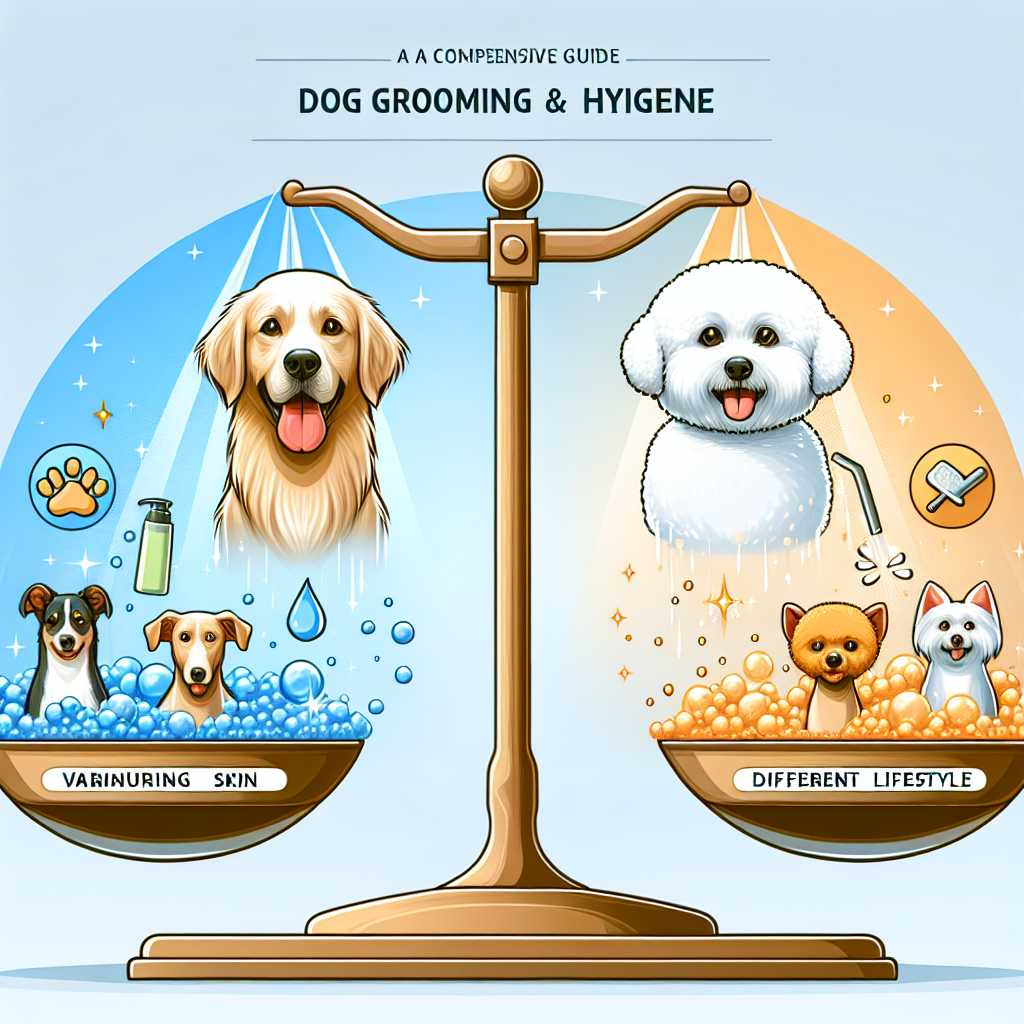If you’re a proud dog owner, you’ve probably asked yourself this question at some point: how often should I bathe my dog? It’s a topic that many pet parents find themselves pondering, as we strive to keep our furry friends clean and comfortable. While there isn’t a one-size-fits-all answer, understanding some key factors can help you determine the ideal bathing frequency for your canine companion. So, whether you have a playful Pomeranian or a majestic Mastiff, read on to discover some helpful guidelines for keeping your beloved pooch fresh and smelling great.

Frequency of Bathing
Factors to Consider
When it comes to determining the frequency of bathing for your furry friend, there are several important factors to consider. These factors include your dog’s coat type, breed, lifestyle, and any skin issues they may have. By taking these factors into account, you can establish a bathing routine that keeps your dog clean and healthy without causing any unnecessary stress or harm.
Bathing Guidelines Based on Coat Type
Different coat types require different bathing frequencies. For short-haired breeds, such as Beagles or Boxers, a bath every three months is usually sufficient. On the other hand, dogs with medium-length hair, like Golden Retrievers or Cocker Spaniels, may benefit from a bath every one to two months. Long-haired breeds, such as Shih Tzus or Afghan Hounds, often require more frequent bathing, with a recommended interval of every two to three weeks.
Bathing Frequency for Dogs with Skin Issues
If your dog has skin issues, such as allergies or dermatitis, their bathing frequency may need to be adjusted. In these cases, it’s best to consult with your veterinarian to determine the appropriate bathing schedule. They may recommend medicated shampoos or specific bathing techniques to alleviate your dog’s skin problems.
Bathing Guidelines Based on Breed
Short-Haired Breeds
Short-haired breeds typically require less frequent bathing compared to their long-haired counterparts. As mentioned earlier, a bath every three months is generally suitable for short-haired dogs. However, it’s essential to regularly brush your short-haired dog to remove loose hair and maintain their coat’s health and shine.
Medium-Haired Breeds
Medium-haired breeds, which include breeds like Australian Shepherds or Border Collies, benefit from more regular baths than their short-haired counterparts. A bath every one to two months should help keep their medium-length coats clean and free from tangles. Additionally, brushing your medium-haired dog regularly will help prevent matting and shedding.
Long-Haired Breeds
Long-haired breeds require the most frequent bathing due to the nature of their coat. These breeds often have hair that easily collects dirt, debris, and even urine, leading to unpleasant odors and potential skin issues. Bathing a long-haired dog every two to three weeks will help keep their coat clean and prevent matting. Regular brushing and grooming are also crucial for maintaining their beautiful, flowing locks.
Bathing Guidelines Based on Lifestyle and Activities
Outdoor and Active Dogs
If your dog spends a lot of time outdoors, especially if they are active and enjoy exploring nature, they may require more frequent bathing. Outdoor activities can lead to a dirtier coat, as your dog may come into contact with mud, dirt, or possibly even parasites. In these cases, a bath every month or every two weeks may be necessary to keep your dog clean and prevent any potential skin issues.
Indoor and Less Active Dogs
Indoor dogs who spend most of their time in a clean, controlled environment may require less frequent baths. If your dog is less active and doesn’t get dirty often, a bath every two to three months could be sufficient. However, it’s important to remember that even indoor dogs can accumulate dirt and develop odors over time, so regular grooming and brushing are still necessary.
Bathing Techniques
Pre-Bath Preparation
Before bath time, it’s essential to prepare your dog and the bathing area to ensure a smooth and stress-free experience. Start by gathering all the necessary bathing supplies, such as a dog-friendly shampoo, towels, and a brush. Brush your dog’s coat thoroughly to remove any loose hair or tangles. Also, take this opportunity to check for any skin issues, such as rashes or hot spots, which may require special attention or veterinary care.
Choosing the Right Shampoo
Selecting the right shampoo for your dog is crucial for their overall skin and coat health. Avoid using human shampoos, as they can be too harsh and strip your dog’s coat of its natural oils. Instead, opt for a high-quality, specially formulated dog shampoo that suits your dog’s specific needs. There are shampoos available for sensitive skin, dry skin, and even flea and tick control. Consult with your veterinarian if you’re unsure which shampoo is the best choice for your dog.
Bathing Steps
When it’s time for the bath, make sure the water is lukewarm, as hot water can be uncomfortable for your dog. Wet your dog’s coat thoroughly and apply the shampoo, gently massaging it into their skin and coat. Be sure to avoid getting shampoo in their eyes, ears, or mouth. Rinse your dog thoroughly, ensuring that no shampoo residue remains. Remember to be patient and gentle throughout the bathing process, as dogs can be sensitive to sudden movements or loud noises.
Drying and Brushing
After the bath, gently towel dry your dog, removing as much excess water as possible. If your dog tolerates it, you can also use a pet dryer on a low setting to speed up the drying process. Once your dog is mostly dry, it’s time to brush their coat again to remove any remaining tangles and prevent matting. Regular brushing after bathing will help maintain your dog’s coat and keep it looking its best.

Signs Indicating the Need for a Bath
Unpleasant Odor
If your dog has a persistent and unpleasant odor, it’s a clear sign that they need a bath. The smell may be caused by dirt, bacteria, or even an underlying skin condition. Regular bathing can help eliminate odors and keep your dog smelling fresh.
Visible Dirt and Stains
If you notice visible dirt, stains, or debris on your dog’s coat, it’s a good indicator that they need a bath. Dogs that spend time outdoors or engage in messy activities are more prone to accumulating dirt and stains on their fur. A thorough bath will help remove these unwanted substances and keep your dog looking clean and presentable.
Excessive Shedding
While shedding is a natural process for dogs, excessive shedding can be a sign of an underlying issue. If you notice an increase in shedding or if your dog’s coat appears dull and lacks luster, it may be time for a bath. Regular baths, paired with proper grooming and brushing, can help reduce shedding and keep your dog’s coat healthy and shiny.
Scratching or Irritated Skin
If your dog is scratching or displaying signs of irritated skin, it could be an indication that they need a bath. Bathing can help relieve itching and remove any allergens or irritants from your dog’s coat. However, if the scratching persists or worsens after bathing, it’s important to consult with your veterinarian to rule out any underlying skin conditions or allergies.
Potential Risks of Over-Bathing
Stripping Natural Oils
Over-bathing can strip your dog’s coat of its natural oils, leading to dryness and skin irritation. These natural oils help to keep your dog’s skin moisturized and their coat healthy. Bathing too frequently can disrupt this delicate balance and result in discomfort for your dog.
Dry and Flaky Skin
Frequent bathing can also cause dry and flaky skin in dogs. Just like how our skin can become dry and itchy with excessive bathing, the same can happen to dogs. If your dog’s skin appears dry or if they show signs of discomfort, such as excessive scratching, it’s important to reassess their bathing frequency and possibly adjust it accordingly.
Skin Allergies and Irritations
Some dogs are more prone to skin allergies and sensitivities. Over-bathing can aggravate these conditions, causing further irritation and discomfort for your dog. If your dog has known allergies or sensitive skin, it’s crucial to follow bathing guidelines that are specifically tailored to their needs. Consulting with your veterinarian can provide you with the best course of action to minimize any potential risks.

Benefits of Regular Bathing
Maintaining Healthy Skin and Coat
Regular bathing, when done appropriately, can help maintain your dog’s healthy skin and coat. It removes dirt, debris, and allergens from their fur, preventing them from building up and causing skin issues. Additionally, bathing can stimulate the production of natural skin oils, giving your dog’s coat a healthy and shiny appearance.
Reducing Allergens and Shedding
Bathing your dog regularly can help reduce allergens, such as dander, that can cause allergies in humans. It can also help minimize shedding, as loose hair is removed during the bath. Regular grooming and brushing after bathing further aid in reducing allergens and keeping shedding under control.
Preventing Infections
Bathing plays a vital role in preventing skin infections. By keeping your dog’s coat clean, you reduce the chances of bacteria, fungi, or other harmful microorganisms from thriving on their skin. Regular baths also allow for early detection of any skin issues, allowing you to promptly address them before they escalate into more serious infections.
Common FAQs about Bathing Dogs
Can I Bathe My Puppy?
Yes, you can bathe your puppy, but it’s important to do so using a gentle puppy shampoo specifically formulated for their delicate skin. Puppy coats are more sensitive, and over-bathing can disrupt the natural oils and irritate their skin. It’s advisable to consult with your veterinarian for guidance on the appropriate bathing frequency and techniques for your puppy.
Can I Use Human Shampoo?
No, you should never use human shampoo on your dog. Human shampoos are formulated for our pH levels and can be too harsh for your dog’s skin and coat. They can strip away the natural oils, leading to dryness, itching, and potential skin issues. Always opt for a dog-specific shampoo that is tailored to their needs.
Should I Bathe My Dog Before or After Grooming?
In general, it’s best to bathe your dog before grooming. Bathing cleanses the coat and prepares it for grooming, making the process easier for both you and your dog. However, some grooming services may require a specific order, so it’s advisable to consult with your groomer for their recommendations.
What if My Dog Hates Bath Time?
If your dog dislikes bath time, there are several strategies you can try to make the experience more enjoyable for them. Start by gradually introducing them to water and the bathing process, using positive reinforcement and treats to create a positive association. Use a non-slip mat in the tub to ensure your dog feels secure, and consider using gentle massage techniques to help them relax. If your dog’s fear or anxiety persists, you may want to seek assistance from a professional dog trainer or behaviorist.

Conclusion
Bathing your dog is an essential part of their overall care and hygiene. By considering factors such as your dog’s coat type, breed, lifestyle, and skin issues, you can establish a bathing routine that suits their needs. Remember to choose the right shampoo, follow proper bathing techniques, and be mindful of any signs indicating the need for a bath. Regular bathing not only keeps your dog clean and smelling fresh but also contributes to their overall health and well-being. So grab that shampoo, enjoy bath time with your furry friend, and keep them looking and feeling their best!




